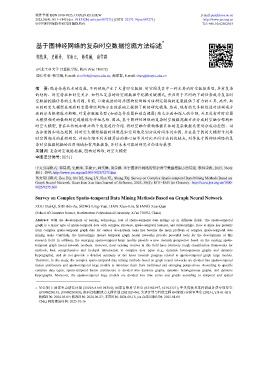Page 405 - 《软件学报》2025年第4期
P. 405
软件学报 ISSN 1000-9825, CODEN RUXUEW E-mail: jos@iscas.ac.cn
2025,36(4):1811−1843 [doi: 10.13328/j.cnki.jos.007275] [CSTR: 32375.14.jos.007275] http://www.jos.org.cn
©中国科学院软件研究所版权所有. Tel: +86-10-62562563
*
基于图神经网络的复杂时空数据挖掘方法综述
邹慧琪, 史彬泽, 宋凌云, 韩笑琳, 尚学群
(西北工业大学 计算机学院, 陕西 西安 710072)
通信作者: 韩笑琳, E-mail: xiaolinh@nwpu.edu.cn; 尚学群, E-mail: shang@nwpu.edu.cn
摘 要: 随着传感技术的发展, 不同领域产生了大量时空数据. 时空图是其中一种主要的时空数据类型, 具有复杂
的结构、时空特征和时空关系. 如何从复杂的时空图数据中挖掘关键模式, 并应用于不同的下游任务成为复杂时
空数据挖掘任务的主要问题. 目前, 日渐成熟的时序图神经网络为该研究领域的发展提供了有力的工具. 此外, 新
兴的时空大模型在现有时空图神经网络方法的基础上提供了新的研究视角. 然而, 现有的大多数综述对该领域方
法的分类框架较为粗略, 对复杂数据类型 (如动态异质图和动态超图) 缺乏全面和深入的介绍, 并且没有对时空图
大模型相关的最新研究进展进行详细总结. 因此, 基于图神经网络的复杂时空数据挖掘方法分成时空融合架构和
时空大模型, 旨在从传统和新兴两个角度进行介绍. 将时空融合架构根据具体的复杂数据类型划分成动态图、动
态异质图和动态超图. 将时空大模型根据时间维度和空间维度划分成时间序列和图, 并在基于图的大模型中列举
时空图相关的最新研究. 详细介绍不同关键算法的核心细节并对比不同方法的优缺点, 列举基于图神经网络的复
杂时空数据挖掘的应用领域和常用数据集, 并对未来可能的研究方向进行展望.
关键词: 复杂时空数据挖掘; 图神经网络; 时空大模型
中图法分类号: TP311
中文引用格式: 邹慧琪, 史彬泽, 宋凌云, 韩笑琳, 尚学群. 基于图神经网络的复杂时空数据挖掘方法综述. 软件学报, 2025, 36(4):
1811–1843. http://www.jos.org.cn/1000-9825/7275.htm
英文引用格式: Zou HQ, Shi BZ, Song LY, Han XL, Shang XQ. Survey on Complex Spatio-temporal Data Mining Methods Based on
Graph Neural Network. Ruan Jian Xue Bao/Journal of Software, 2025, 36(4): 1811–1843 (in Chinese). http://www.jos.org.cn/1000-
9825/7275.htm
Survey on Complex Spatio-temporal Data Mining Methods Based on Graph Neural Network
ZOU Hui-Qi, SHI Bin-Ze, SONG Ling-Yun, HAN Xiao-Lin, SHANG Xue-Qun
(School of Computer Science, Northwestern Polytechnical University, Xi’an 710072, China)
Abstract: With the development of sensing technology, lots of spatio-temporal data springs up in different fields. The spatio-temporal
graph is a major type of spatio-temporal data with complex structure, spatio-temporal features, and relationships. How to mine key patterns
from complex spatio-temporal graph data for various downstream tasks has become the main problem of complex spatio-temporal data
mining tasks. Currently, the increasingly mature temporal graph neural networks provide powerful tools for the development of this
research field. In addition, the emerging spatio-temporal large models provide a new research perspective based on the existing spatio-
temporal graph neural network methods. However, most existing reviews in this field have relatively rough classification frameworks for
methods, lack comprehensive and in-depth introduction to complex data types (e.g., dynamic heterogeneous graphs and dynamic
hypergraphs), and do not provide a detailed summary of the latest research progress related to spatio-temporal graph large models.
Therefore, in this study, the complex spatio-temporal data mining methods based on graph neural networks are divided into spatio-temporal
fusion architecture and spatio-temporal large models to introduce them from traditional and emerging perspectives. According to specific
complex data types, spatio-temporal fusion architecture is divided into dynamic graphs, dynamic heterogeneous graphs, and dynamic
hypergraphs. Moreover, the spatio-temporal large models are divided into time series and graphs according to temporal and spatial
* 基金项目: 国家重点研发计划 (2020AAA0108504); 国家自然科学基金 (62302397, 62102321); 中央高校基本科研业务费专项资金
(D5000230191, D5000230095); 陕西省创新能力支撑计划 (2021TD-06); 先进计算与智能工程 (国家级) 实验室基金 (2023-LYJJ-01-021)
收稿时间: 2024-05-09; 修改时间: 2024-06-27; 采用时间: 2024-08-15; jos 在线出版时间: 2025-01-08
CNKI 网络首发时间: 2025-01-16

